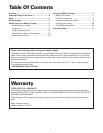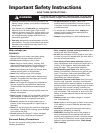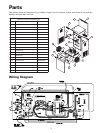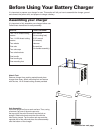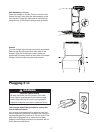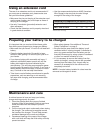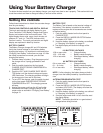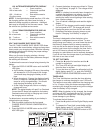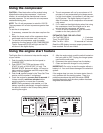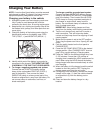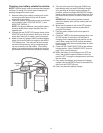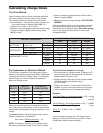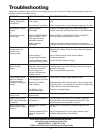
6
MINIMUM RECOMMENDED EXTENSION CORD
Length of Cord, in Feet 25 50 100 150
AWG* Size of Cord 16 14 10 8
*AWG=American Wire Gauge
Using an extension cord
The use of an extension cord is not recommended. If
you must use an extension cord, please make sure
that you follow these guidelines:
• Make sure the pins on the plug of the extension cord
are the same number, size, and shape as those of
the plug on the charger.
• Use only 3-conductor (grounded) extension cord
when necessary.
• Check that the extension cord is properly wired and
in good electrical condition.
Preparing your battery to be charged
It is important that you read and follow these guide-
lines while you are preparing to charge your battery.
• Make sure that you have a 12 volt or 6 volt lead-acid
battery.
• Clean the battery terminals. Be careful to keep
corrosion from getting in or around your eyes or on
your hands.
• If you have a battery with removable cell caps, if
required, add distilled water to each cell until the
battery acid reaches the level indicated by the
manufacturer. This will help purge excessive gases
from the cells. Be careful not to overfill. If you have a
sealed battery without cell caps, no action is neces-
sary. Continue to the next step listed below.
• Take time to read all battery manufacturer’s specific
precautions, such as removing or not removing
cell caps while charging, and recommended rates
of charge.
• Wear safety glasses. See additional "Personal
Safety Precautions" on page 2.
• Be sure that the area around the battery is well
ventilated while it is being charged. If ventilation is
poor, any gases emitted from the battery can be
manually blown away by using a piece of cardboard
or other non-metallic material as a fan.
• If it is necessary to remove the battery from the
vehicle to charge it, always remove the grounded
terminal from the battery first. A spark may be
caused if all accessories in the vehicle are not
completely turned off.
NOTE: A marine battery installed in a boat must be
removed and charged on shore.
• Use the recommended minimum AWG (American
Wire Gauge) to be sure that wire size is large
enough for the rating of the charger.
A minimal amount of care can keep your battery
charger working properly for years.
1. Clean the clamps each time you are finished
charging. Wipe off any battery fluid that may have
come in contact with the clamps to prevent
corrosion.
2. Coil the input and output cords neatly when storing
the charger. The cords can be wrapped around
the handle of the charger. This will help prevent
accidental damage to the cords and charger.
3. Occasional cleaning of the case of the charger
with a soft cloth will keep the finish shiny and help
prevent corrosion.
Maintenance and care




